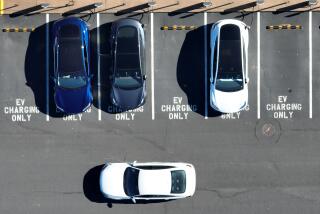Tollway Forecast: a Rough Road
Toll revenue for the struggling San Joaquin Hills turnpike through western Orange County will earn less than half the money predicted when the highway was refinanced six years ago, a new traffic study shows.
The forecast disclosed Tuesday by the Transportation Corridor Agencies indicates the depth of the 15-mile toll road’s financial predicament. The highway has been plagued for several years by lower-than-expected revenue and bonds that have been downgraded to junk status.
“No amount of toll increases will overcome the gap,” said Linda Lindholm, a Laguna Niguel councilwoman who chairs the board of directors for the San Joaquin Hills Transportation Corridor. “We certainly have a challenge ahead.”
Walter D. Kreutzen, TCA’s chief executive, said he was not surprised by the money problems. “We told the board in 2000 that we are concerned about the long-term financial health of the San Joaquin Hills,” he said. “Today, revenue continues to lag projections.”
The new traffic and revenue study by Vollmer Associates, a consulting firm hired by the TCA, is dramatically different from research completed in 1997 by Wilbur Smith & Associates. The Smith analysis was done in anticipation of refinancing about $1.4 billion in San Joaquin Hills bonds at lower interest.
Toll revenue for the highway was about $61.1 million for 2002-03, far lower than the $79.6 million predicted by Smith & Associates. Figures for the highway show the gap between actual and projected revenue has been widening steadily over the last few years, prompting two Wall Street ratings agencies to lower their assessments of San Joaquin Hills bonds to junk status.
In the new study, Vollmer estimates that revenue will be $78.7 million for the highway in fiscal year 2010-11. In contrast, the Smith firm projected that revenue would be $144.3 million for the same year.
For fiscal year 2025-26, Vollmer predicts that toll revenue will be about $133 million, less than half the original $312 million forecast by Smith & Associates.
Overall, TCA officials say they are facing a shortfall in toll revenue of about $1 billion for San Joaquin Hills over the next four decades. Meanwhile, the road’s debt payments, including interest and principal, will rise steadily from about $59 million for 2003 to $180 million for 2025.
Gerry Nielsten of Vollmer Associates blamed the shortfalls in revenue on slower-than-expected population growth in south Orange County and the widened Interstate 5, which runs parallel to the toll road.
If nothing is done to reverse the tollway’s finances, Kreutzen said, the San Joaquin Hills will be in technical default on at least $1.5 billion in bonds by 2005 and partial default on interest payments to investors by 2012.
Technical default occurs when the agency cannot comply with a promise to bond holders to take in $1.30 in revenue for every $1 it spends. If a partial default occurs, Kreutzen said, the agency might be able to pay only 90 cents of every $1 owed. The debt, however, ultimately has to be repaid, but at a later date.
Just as significant, the TCA’s credit rating could suffer, making it difficult to obtain financing to extend the Foothill South from Oso Parkway to Interstate 5 south of San Clemente.
To prevent a possible default, the boards of directors for the San Joaquin Hills and the more financially healthy Foothill-Eastern toll road are considering a merger of the two operations.
More to Read
Sign up for Essential California
The most important California stories and recommendations in your inbox every morning.
You may occasionally receive promotional content from the Los Angeles Times.











